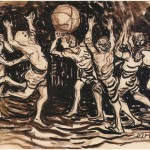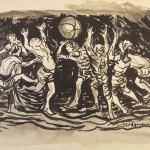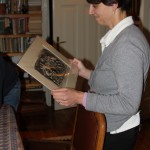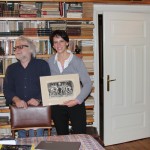 I first discovered photographs of Moshe Rynecki paintings for sale on Allegro.pl, a Polish auction site, a few years ago. I don’t speak or read Polish, but the wording in one of the listings was “Rarytas,” a cognate for “rarity” or “collector’s item,”information I could piece together from context. These pieces, the various sellers proclaimed, were real paintings by Moshe Rynecki, a Jewish artist from the interwar years who had perished in the Holocaust. I strained to learn something…anything…from the thumbnail photos included with each of the postings, but they were too small and grainy, yielding little insight about the work.
I first discovered photographs of Moshe Rynecki paintings for sale on Allegro.pl, a Polish auction site, a few years ago. I don’t speak or read Polish, but the wording in one of the listings was “Rarytas,” a cognate for “rarity” or “collector’s item,”information I could piece together from context. These pieces, the various sellers proclaimed, were real paintings by Moshe Rynecki, a Jewish artist from the interwar years who had perished in the Holocaust. I strained to learn something…anything…from the thumbnail photos included with each of the postings, but they were too small and grainy, yielding little insight about the work.
I eventually worked up the courage to write to the sellers and buyers of each of the pieces. My emails to the sellers were all pretty much of the same form: I am the great-granddaughter of Moshe Rynecki. You listed a piece for sale on Allegro that he painted. Can I please have better quality images of the paintings you’ve posted? How did you get these works? To the buyers I said I knew they’d bought the work. I pleaded to know more. Could they send me photographs? Why had they purchased a piece of my great-grandfather’s work? Were they collectors of Jewish art from the interwar years?
My emails were, perhaps, too aggressive. Or maybe the mere fact that I am the great-granddaughter of Moshe Rynecki frightened off most people. Only one man, Edward N., wrote back to me, sending me photos of the piece he had bought on Allegro. When I asked if I might come to his home to interview him, he responded affirmatively, but said I’d need to bring a translator.
A few days ago, on Saturday, I went meet Edward. He lives in what one might call a pleasant, leafy suburb of Warsaw. The homes, many of them pre-war homes, are elegant but simple. The street is lined with trees, the grounds of the homes are spacious; it is a quiet, peaceful place where a walk in the autumn yields lovely vistas of fall leaves.
When we arrived, the gate to Edward’s yard was locked. I rang a bell, and Edward came out almost immediately. An avuncular looking man with almost shoulder length gray hair, he seemed relaxed, at ease with himself. “Dzien dobry,” I said, a phrase I’ve grown comfortable with over my time in Poland. It’s a friendly greeting. It seemed particularly important to try to say something in Polish. I stuck out my hand, saying “Elzbieta Rynecka,” (Elzhbyeta Rinetska) I said, choosing to use the Polish pronunciation of my name. He said something in Polish which I didn’t understand, but gestured towards his home. I followed him to the front door along with my film team, Slawomir Grunberg, Catherine Greenblatt, and the Diuna translator, Mateusz Majewski, all climbing the stairs to the top floor of his home.
Edward’s house is a home in the truest sense of the word. It’s been lovingly decorated with a gentle accrual over time of art, books, and family photographs. In the front hallway his wife and daughter greeted me. “Please, please, come in,” Edward’s wife said, gesturing toward the table in a sitting room library, and then asked what we would like to drink. As we sat, she left the room, but quickly returned with a tray of tea and classic Polish apple cake. Drinking tea, and eating the truly amazing homemade apple cake, we made small talk about the lovely drive to their home, about the family’s expansive collection of books, and about the family dog, Buenos. And then it was time to see the Moshe Rynecki piece and begin filming.
Edward had the black and white drawing in a mat and a protective plastic cover. He gestured to me to remove it from the plastic so that I could look at it more closely. He spoke in Polish and the translator said, “He wants to know if you think it’s real.” I paused. I’d thought about this moment a great deal before coming to Poland. “I’m not really sure,” I said. The piece is a lot like one held by ZIH (The Jewish Historical Institute in Warsaw) and while it’s possible that my great-grandfather made different studies of the same image, something about the signature seems not quite right.” I waited for the translator to explain this to Edward and I took a moment to plan what I wanted to say next. “But I’ve signed my name a lot in my lifetime, and it doesn’t always come out exactly the same,” I explained. “I just really don’t know.” Edward nodded his head and pointed to my laptop. The translator explained that Edward wanted to know if I had a photograph of the piece like his that is held at ZIH. I opened the file and we held Edward’s piece about the screen of my laptop. Edward looked contemplative as he stared at the two images side by side.
- Piece held by ZIH
- Piece listed on Allegro
Edward asked to see other pieces held by ZIH. He wanted to know more about my great-grandfather’s life, his body of work. He asked me to tell the story of how my family managed to recover some of the art after the war.
Edward and I spoke for about an hour across a gap of language, but feeling like we understood one another in a way that surpasses translation. He clearly understood my dedication to finding my great-grandfather’s lost work. And I understood, not just from the translated words, but from his gestures, mannerisms, and other Jewish art displayed in his home, his profound dedication to the world of Jewish culture and art. Our primary connection was not through language; we understood each other more through art.
After about two hours it was time to wrap up the interview. I thanked Edward for allowing me to visit him in his home. “Dziękuje,” I said, “Thank you.” We stood up and hugged. Then Edward picked up the painting off the table and held it out toward me. “He wants you to have the piece,” the translator said. “Really? Are you sure?” I asked. “He says it’s yours. It belongs to your family.”
The truth is that I’m not sure if the painting Edward gave me is truly a work by my great-grandfather. Before I came to Poland, this question haunted me. I met with an attorney friend for advice, I read articles about the prevalence of fakes entering the art market, and ultimately I tried to understand whether, if it was a fake, why someone would bother with my great-grandfather’s work. While my great-grandfather was somewhat known in Warsaw in the interwar years, he was never famous. His name is “well known” only within the relatively small circle of those who study Polish Jewish culture from the 1920’s and 1930’s. But in that moment, the moment Edward placed the painting in my hands, none of that mattered. What mattered was Edward’s gesture – an effort to right a wrong from history – to take what may have been looted in the aftermath of the Second World War and to return it to the heir who had come searching for answers. It was a moment that moved me beyond the power of words.




